Awase dashi made easy–learn 3 foolproof methods and the why behind each step. Get richer, more flavorful Japanese soup stock every time.
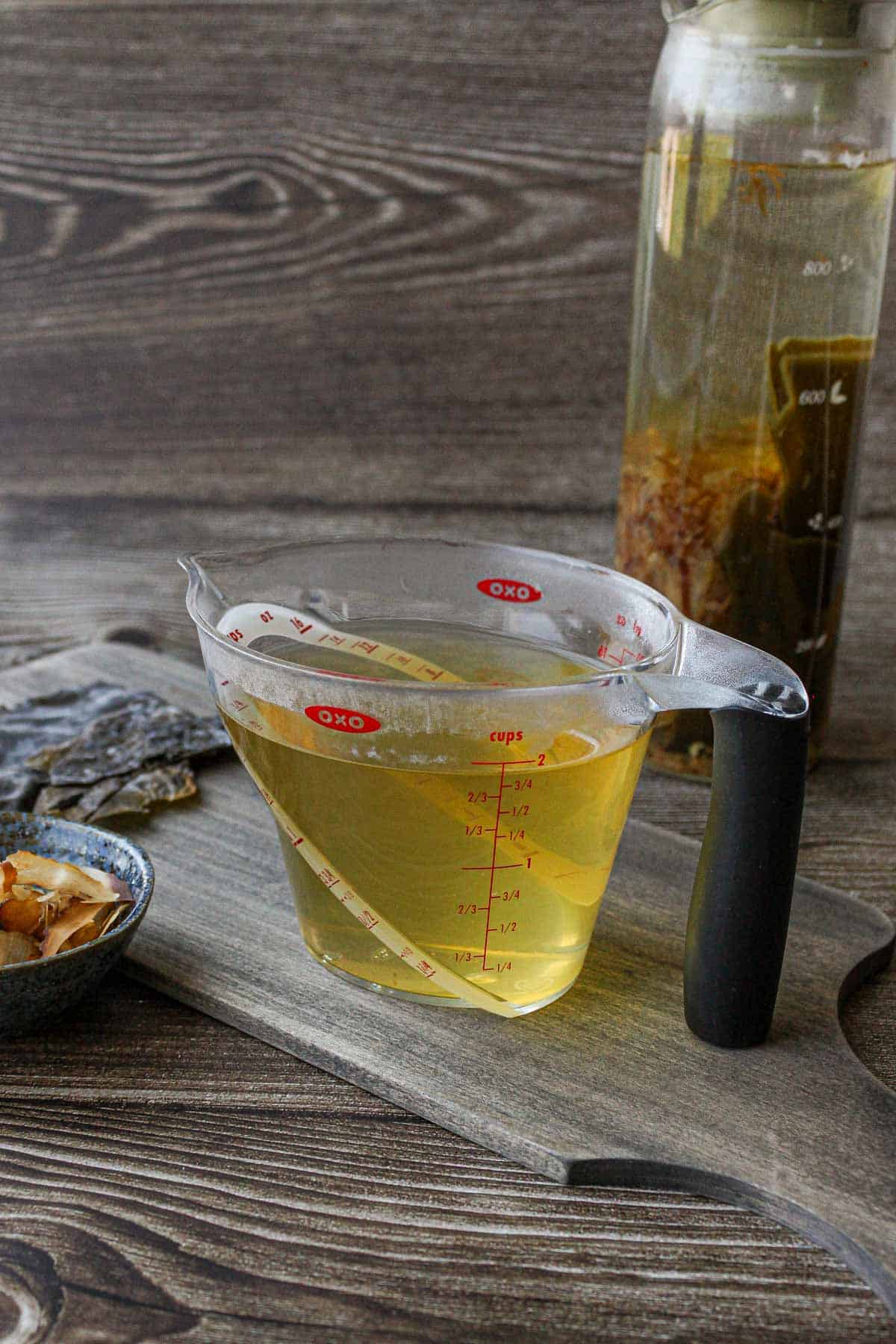
I used to rely only on dashi packs (Kayanoya is/was my favorite!) because I thought making dashi from scratch was too much work. But once I tried it, I realized it’s super easy, especially if you start soaking the ingredients in the morning. You’ll have homemade dashi by dinner in just a few steps!
Awase dashi is my go-to for all kinds of Japanese dishes like miso soup with tofu, oden, and simmered dishes. I hope this recipe, and the little cooking science sprinkled in, helps you feel confident making it at home. 🙂
💡Curious about dashi? Check out my complete Dashi Guide to learn all about it!
Jump to:
- Why You'll Love This Recipe
- What are Awase, Ichiban, and Niban Dashi?
- Notes on Ingredients
- Substitutions and Variations
- Why Mix Both Kombu and Katsuobushi?
- How to Adjust Dashi Based on How You'll Use It
- How to Make Awase Dashi
- Reusing Dashi Ingredients
- Kurumi's Tips
- How to Use Awase Dashi
- Storage Instructions
- FAQs
- Explore Other Types of Dashi
- 📖Recipe
- 🎁FREE Dashi Cheat Sheet
- 📌Pin This Recipe For Later!
Why You'll Love This Recipe
- Stress-free and sustainable: I’ll walk you through three different ways to make awase dashi, so you can choose the method that fits your lifestyle best, whether you’re in a rush or have time to slow down.
- Science-backed but doable: I dug into the best ways to bring out maximum umami (hello, cooking science nerds! 🙋♀️), then simplified the technique so you can do it easily at home with no fancy tools needed.
- Super flexible: I’ll show you how to adjust the ratio of ingredients to water so you can make dashi that’s just right for how you plan to use it, whether it's for miso soup, mentsuyu, or anything in between.
- Adjusted for readers outside Japan: I made a few tweaks to help this recipe work well even if you don’t have the “ideal” dashi-making setup, like super high-quality kombu, fancy bonito flakes, or soft water. So even if you’re outside Japan, you can still make delicious dashi at home 🙂
What are Awase, Ichiban, and Niban Dashi?
Awase dashi is a classic Japanese soup stock made by combining two ingredients: kombu (dried kelp) and katsuobushi (bonito flakes). It has a balanced flavor with deep umami and works well in all kinds of dishes.
There are two types of dashi: ichiban dashi and niban dashi.
- Ichiban dashi is the first brew, made with fresh ingredients. It has a clean, delicate flavor and is perfect for dishes that highlight the taste of dashi, like suimono (clear soup) or chawanmushi (savory egg custard).
- Niban dashi is the second brew, made by reusing the same kombu and katsuobushi from ichiban dashi. It’s not as refined, but still has good umami and is great for everyday dishes like miso soup or nimono (simmered dishes).
In home cooking, most people just make ichiban dashi and use it for everything. Some also mix ichiban and niban dashi to stretch the batch and reduce waste.
Notes on Ingredients
See the recipe card for the full ingredients list.
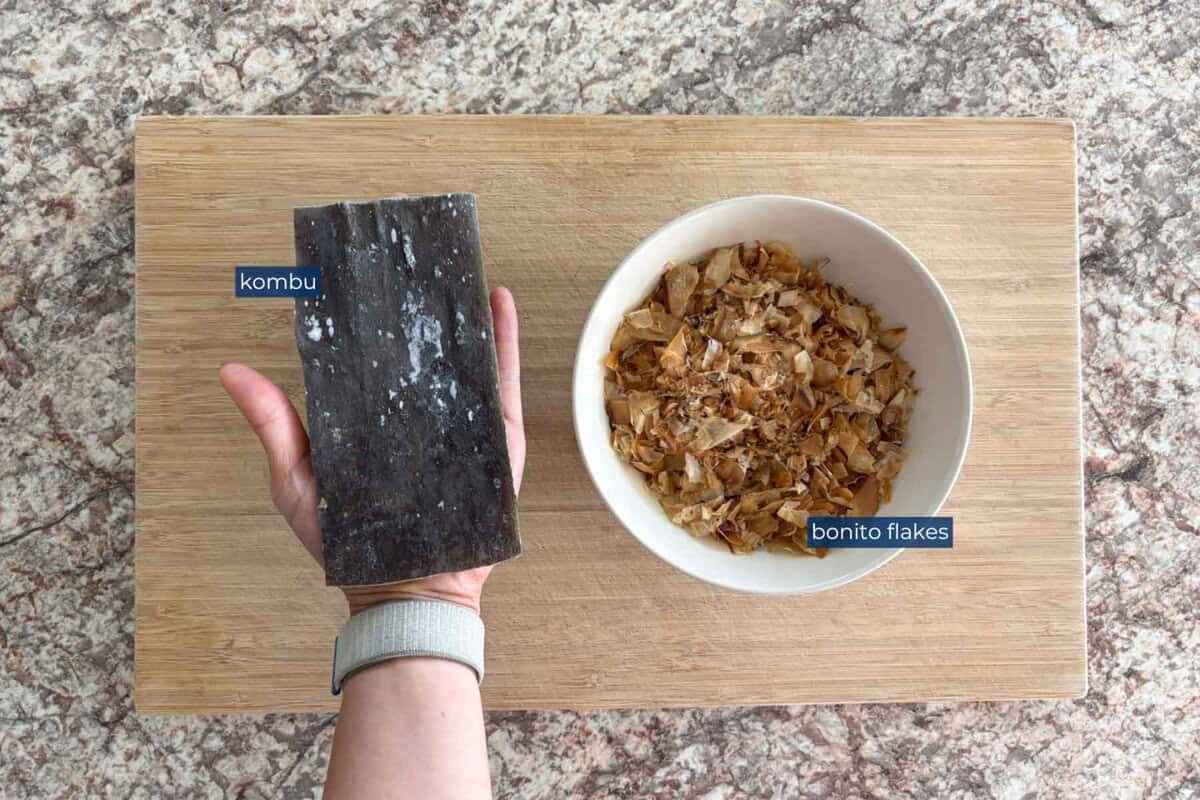
Kombu (Dried Kelp)
There are four main types of kombu used for dashi in Japan: Rishiri, Ma, Rausu, and Hidaka.
For awase dashi, since it’s combined with bonito flakes, you want kombu that has presence but isn’t overpowering. Ma kombu or Rishiri kombu are ideal, but they're hard to find and usually expensive outside Japan.
If you're in the States, look for kombu that:
- Comes in large sheets (not pre-cut strips)
- Feels thick and firm
I tested with WEL-PAC Dashi Kombu, and it worked well.
👉 Quick tip: The white powder on the surface isn’t mold, it’s natural glutamate (aka umami)! So don’t rinse your kombu. You’d be washing the flavor away.
👉 Why not just use MSG?
Kombu has natural umami, plus minerals and other nutrients. MSG mimics umami but doesn’t offer the same health benefits.
Katsuobushi (Dried Bonito Flakes)
There are different types depending on flake thickness:
- Usu-kezuri (薄削り) – thin shaved
- Chiai-nuki (血合抜き) – bloodline removed
- Atsu-kezuri (厚削り) – thick shaved
The most versatile and easy-to-find type is usu-kezuri (thin shaved). It releases umami quickly and preserves the aroma well.
Try to avoid the super fine “topping” flakes, they’re too powdery. I recommend something like Kaneso Hanakatsuo or other standard bonito flakes.
Water
Water quality affects dashi more than you might think. Soft water is better because it draws out more umami.
Hard water (which has more calcium and magnesium) makes it harder to extract flavor and can cause cloudiness or bitterness.
Since most tap water in the U.S. is hard, I recommend using a water filter like Brita to soften it. It’s cheaper and more eco-friendly than buying bottled soft water every time.
💡You can find these ingredients at Japanese or Asian grocery stores, or online at Amazon or Weee!
Substitutions and Variations
- Kombu: If you can’t find kombu or need to avoid it, try other types of dashi that don’t use it, like katsuo dashi, iriko dashi, or shiitake dashi. Or, if you want to experiment, you can swap kombu for other umami-rich ingredients that are high in glutamic acid or guanylic acid, like dried shiitake mushrooms, vegetables, or even MSG powder, if you’re open to it.
- Katsuobushi (Bonito Flakes): You can replace katsuobushi with other fish-based umami sources like dried anchovies (iriko or niboshi). To use niboshi, soak about 10g of dried anchovies with kombu, heat gently, remove the kombu as instructed in the recipe, and simmer the anchovies for about 5 minutes.
- Shortcut Options: If you forgot to soak the ingredients or need dashi fast, dashi powder is a handy backup. To mimic awase dashi, mix kombu dashi powder and katsuo dashi powder in a 1:2 ratio, or use a dashi pack like Kayanoya Dashi.
💡Think About What You’re Cooking: The key to a flavorful dish is combining an amino acid (like glutamate) with a nucleic acid (like guanylate or inosinic acid). So if you’re swapping ingredients, try to add back the missing umami component somewhere else in the dish.
For example:
- If you can’t use kombu, make bonito dashi (rich in inosinate) and cook with tomatoes or onions (which are high in glutamate).
- If you can’t use bonito flakes, make kombu dashi (rich in glutamate) and use dried shiitake or dried tomatoes (which contain nucleic acids).
👉 If you're curious, here's a list of umami-rich ingredients by their umami compound.
Why Mix Both Kombu and Katsuobushi?
There are three main types of umami compounds:
- Glutamic acid (an amino acid)
- Inosinic acid and guanylic acid (nucleic acids)
Research shows that when you combine an amino acid and a nucleic acid, the umami taste becomes much stronger. This effect is called umami synergy.
Kombu is rich in glutamic acid, and bonito flakes (katsuobushi) are high in inosinic acid. That’s why awase dashi, which uses both, tastes richer and more savory than dashi made from just one ingredient.
Studies also suggest that the umami is strongest when glutamate and inosinic acid are present in a 1:1 ratio. This combination can make the umami taste 7 to 8 times stronger than either one on its own.
To get close to this balance:
- Kombu contains about 1,200–3,400 mg of glutamate per 100g
- Bonito flakes contain about 470–800 mg of inosinic acid per 100g
So, using 10g of kombu and 20g of bonito flakes is a great starting point. It gets you close to that ideal 1:1 ratio for maximum umami.
How to Adjust Dashi Based on How You'll Use It
You can adjust the amount of kombu and bonito flakes depending on how you plan to use the dashi.
Total Ingredient-to-Water Ratio (by weight)
| Ratio | Best For | Notes |
|---|---|---|
| 4% | Dishes that highlight dashi, like suimono and chawanmushi | Rich and flavorful stock often used in Kyoto-style fine dining |
| 3% | My recommendation | This works well when cooking outside Japan because it's harder to find soft water and high-quality dashi ingredients. A 3% ratio helps bring out more umami even in these conditions. |
| 2% | Everyday home cooking | Light, balanced flavor that doesn’t overpower other ingredients |
For example, if you're using 1 liter of water, a 3% ratio means using a total of 30 grams of kombu and bonito flakes combined.
Kombu to Katsuobushi Ratio
| Ratio | Flavor Profile | Best For |
|---|---|---|
| 1:2 | Well-balanced umami from both glutamate and inosinic acid. This pairing boosts umami flavor up to 7 to 8 times more than either alone. | Great for everyday use |
| More kombu | Lighter, more delicate flavor that lingers in the mouth | Perfect for clear soups or refined dishes |
| More katsuobushi | Stronger umami and aroma | Best for miso soup or simmered dishes that need a bold base |
By adjusting both the total concentration and the ratio of ingredients, you can make delicious dashi that fits your dish and works well even outside of Japan.
How to Make Awase Dashi
You can make awase dashi in three different ways depending on your schedule and how hands-on you want to be.
Option 1: Cold Brew (Overnight Method)
Best when you want to prep ahead without cooking.
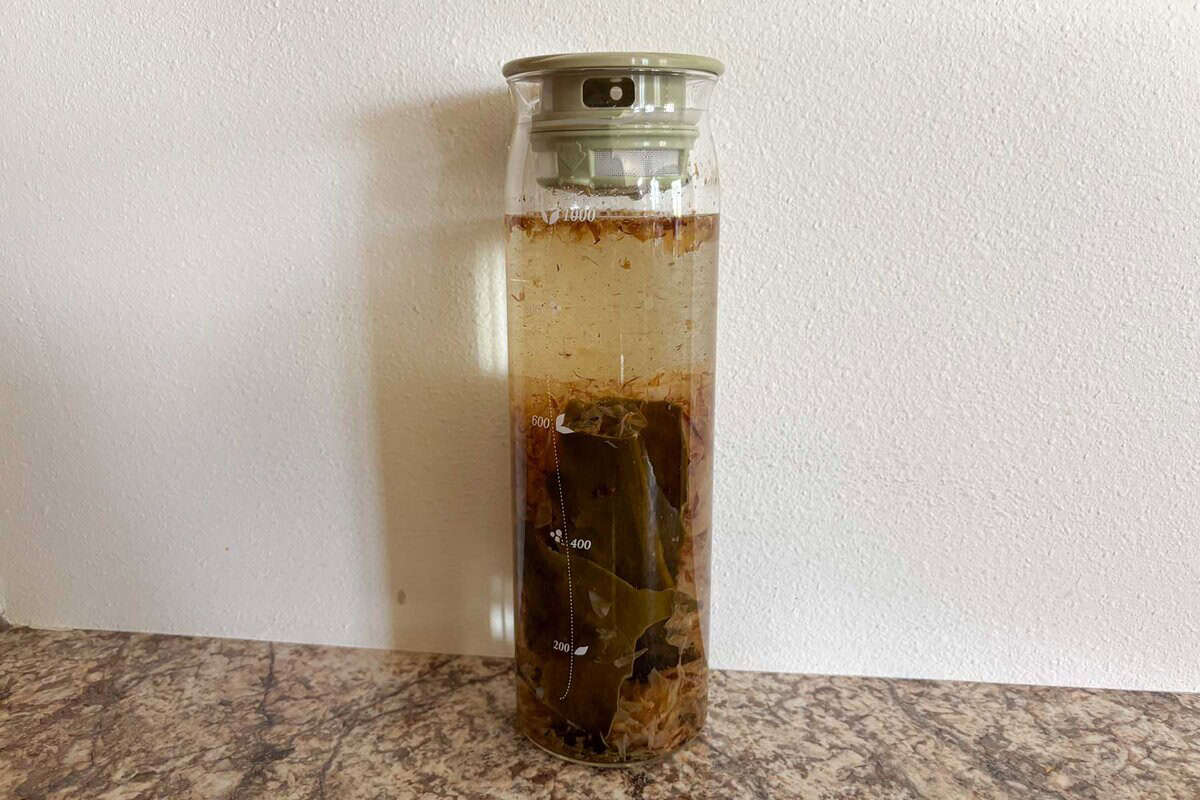
- Add kombu and bonito flakes to a container with water.
- Let it sit in the fridge for 8 to 12 hours.
- Strain out the kombu and flakes.
💡Check out my cold brew dashi guide for more details!
Option 2: Cold Brew Kombu + Hot Steep
A middle-ground method that boosts flavor with a little heat.
- Add kombu and water to a container and cold brew in the fridge for 8 to 12 hours.
- Remove the kombu and pour the liquid into a pot.
- Turn on the heat to medium. Once you see small bubbles rising, turn off the heat.
- Add bonito flakes and let steep for 1 minute.
- Strain through a paper towel or fine strainer. Don’t squeeze the flakes.
Option 3: Quick Steep (Stovetop Method)
The fastest method, perfect when you need dashi right away.
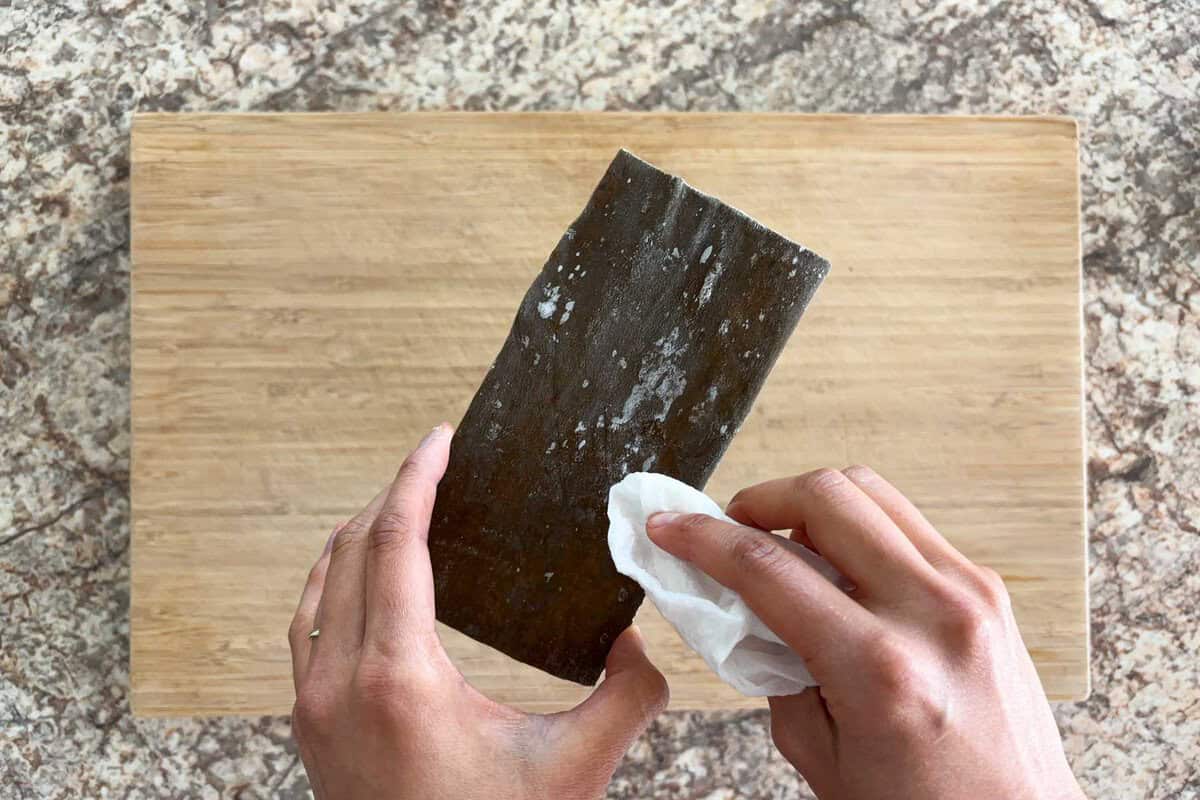
Step 1: Lightly wipe the surface of the kombu.
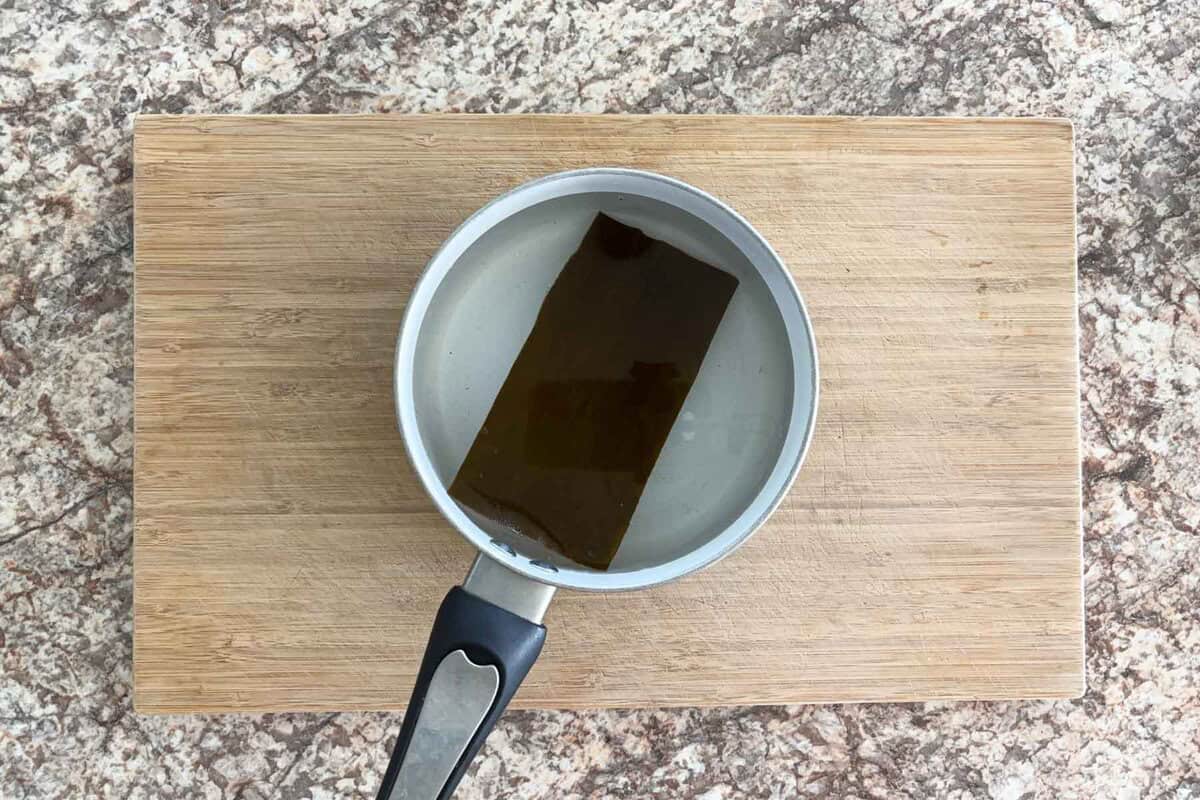
Step 2: Add kombu and water to a pot. Let it soak for 30 minutes to 90 minutes.

Step 3: Heat over medium-low until small bubbles appear around the edges of kombu (don’t boil).

Step 4: Remove the kombu and increase the heat slightly. Once you see small bubbles rising, turn off the heat.
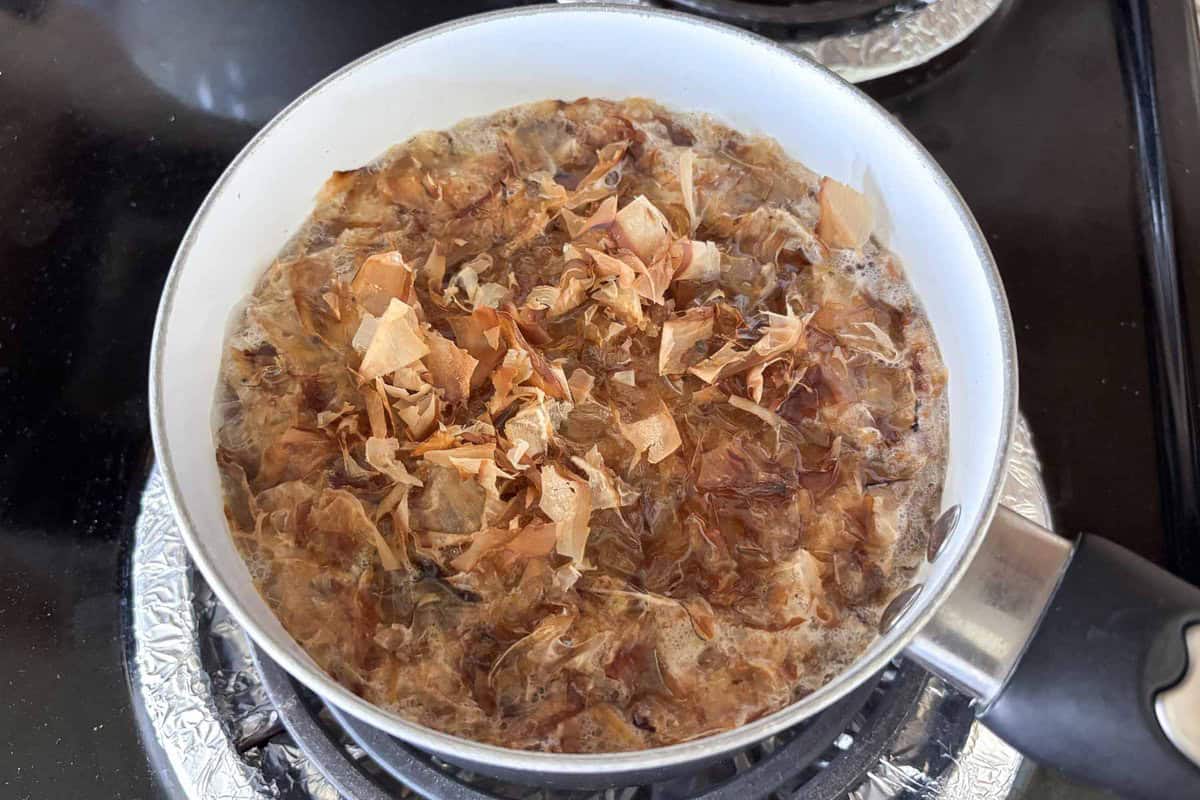
Step 5: Add bonito flakes and let steep for 1 minute.
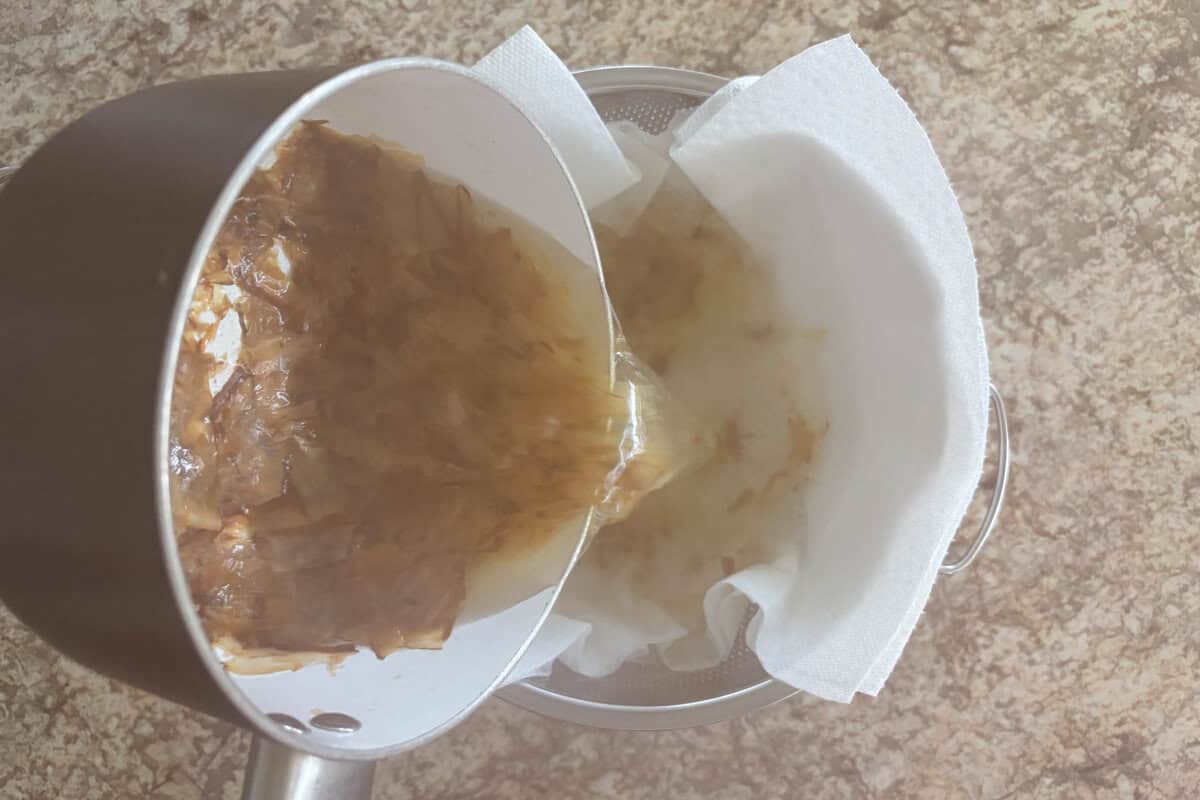
Step 6: Strain through a paper towel over a fine strainer. Don’t squeeze the flakes.
Reusing Dashi Ingredients
Don’t throw away your used kombu or bonito flakes, even if you’ve already made niban dashi! You can still turn them into tasty, no-waste side dishes and seasonings. Here are a few easy ideas:
- Furikake: Chop the ingredients into small pieces, dry-sauté in a pan, and season with soy sauce and mirin. Sprinkle over rice or veggies for an umami boost.
- Tsukudani: Slice into thin strips and simmer with soy sauce, mirin, and sake until soft and flavorful. It stores well and goes perfectly with rice.
- Onigiri Filling: Use tsukudani as a savory filling or mix-in for rice balls.
- Dashi Ponzu: Soak chopped kombu or bonito flakes in ponzu sauce. The added umami is great with grilled dishes like salmon.
- Dashi Soy Sauce (Dashi Shoyu): Soak the used ingredients in soy sauce to create a versatile, umami-rich seasoning for stir-fries, tofu, or fried rice.
Kurumi's Tips
- Don’t rinse the kombu: That white powdery coating on kombu isn’t mold, it’s a natural umami-rich substance called glutamic acid. Never wash off this powder, as it’s essential for the kombu’s flavor.
- Soak kombu before heating: It’s recommended to steep kombu at 60°C for about one hour for the best result, but holding water at that exact temperature at home is tricky without special equipment. So instead, soak the kombu in water for 30 to 90 minutes before heating. It’s a simple way to bring out its flavor without stressing about temperature.
- Watch the pot closely: Temperature is everything when making dashi.
- Kombu releases the most umami around 60°C, which is when you’ll see tiny bubbles at the bottom and/or around the edges of the kombu. Once that happens, remove it right away to avoid slimy or bitter dashi.
- Bonito flakes are best steeped around 85°C, which is just before boiling. You’ll know it’s ready when small bubbles start rising to the surface. Never let it fully boil.
- Don’t cut the kombu: Some recipes suggest scoring or cutting kombu to release more flavor, but that can also lead to sliminess or harsh taste. Since we're soaking and gently heating the kombu, there’s no need to cut it, you’ll still get great umami.
- Don’t sir or squeeze bonito flakes: let them sink in the water naturally and don’t squeeze them over a paper towel. They’ll make the dashi bloody or fishy.
- Make it your own: There’s no one “correct” way to make dashi. Feel free to experiment with ingredient amounts or steeping methods to match your taste. For ideas, check the section on How to Adjust Dashi Based on How You’ll Use It.
How to Use Awase Dashi
Awase dashi has the best of both worlds: deep, long-lasting umami from kombu and bold, aromatic flavor from bonito flakes. That perfect balance makes it super versatile for all kinds of dishes, not just Japanese ones.
Some of the most popular ways to use it include:
- Miso soup: A comforting classic.
- Oden: A cozy simmered dish perfect for cold days.
- Dashimaki tamago: Japanese rolled omelet that’s fluffy, savory, and perfect for bento.
You can also use awase dashi as a base for:
- Simmered dishes (nimono)
- Chawanmushi (savory egg custard)
- Udon and soba soups
- Japanese curry (yes, it adds extra depth!)
Once you have awase dashi in your fridge, you'll find it’s easy to whip up delicious meals any day of the week.
Storage Instructions
- Dashi: Store in an airtight container for up to 3 days in the fridge or 2 weeks in the freezer (ice cubes work great for small portions).
- Used dashi ingredients (kombu and bonito flakes): Pat dry and store in an airtight container for up to 1 week in the fridge or 1 month in the freezer.
FAQs
Awase dashi is made by combining two or more ingredients, most commonly kombu (kelp) and bonito flakes. Katsuo dashi is made with only bonito flakes, so it has a stronger aroma but less depth compared to awase dashi.
Just increase the amount of kombu and bonito flakes! You can adjust the ratio depending on how you plan to use it. See the section How to Adjust Dashi Based on How You’ll Use It for more tips.
Yes! You can swap katsuobushi for other ingredients rich in inosinic acid, like dried anchovies (niboshi). Or, try a different style of dashi, like shiitake dashi or vegan dashi.
It could be due to:
- Using very hard water
- Low-quality kombu or bonito flakes
- Squeezing the ingredients after steeping
Unfortunately, once it’s cloudy or bitter, it can’t be fixed. But you can still use it in miso soup or simmered dishes where the flavor won’t stand out as much.
Yes! Just combine the kombu and bonito flakes with water, and let it steep in the fridge for 8 to 12 hours. Easy and no cooking required.
You can! But you don’t necessarily need to.
The umami synergy is strongest when glutamate (from kombu) and inosinic acid (from bonito) are combined in a 1:1 ratio. Adding more ingredients won’t always make the dashi taste better; it might just throw off the balance.
This is normal! The proteins and natural compounds in dashi can react with seasonings like miso or salt, especially when hot. Just give it a gentle stir or skim the top if needed.
No, since this recipe includes bonito flakes, it’s not safe for those with fish allergies. Try one of my fish-free dashi recipes, like shiitake dashi or vegan dashi instead.
Explore Other Types of Dashi
Awase dashi is just one of several delicious types of dashi, and each one has its own unique flavor and use.
If you’re wondering what makes each type different or how to choose the right one for your cooking, check out my Ultimate Guide to Dashi. It covers everything from the basics to ingredient tips, and it’ll help you find the best dashi for your kitchen.
Ready to try more? Here are other dashi recipes you might like:
- 🌱 Vegan Dashi
- 🍄 Shiitake Dashi
- 🌿 Kombu Dashi
- 🐟 Bonito Dashi (Katsuo Dashi)
- 🐟 Iriko Dashi (Dried Anchovy)
- 🥣 Awase Dashi (You’re here!)
🎁Grab your FREE dashi cheat sheet! Stick it on your fridge and skip Googling recipes every time 🙂
💌 If you tried this recipe and liked it, I’d love to hear from you! Leave a comment and review below or send a photo of your dish to my email. I’d be so happy to see your creation!
📖Recipe
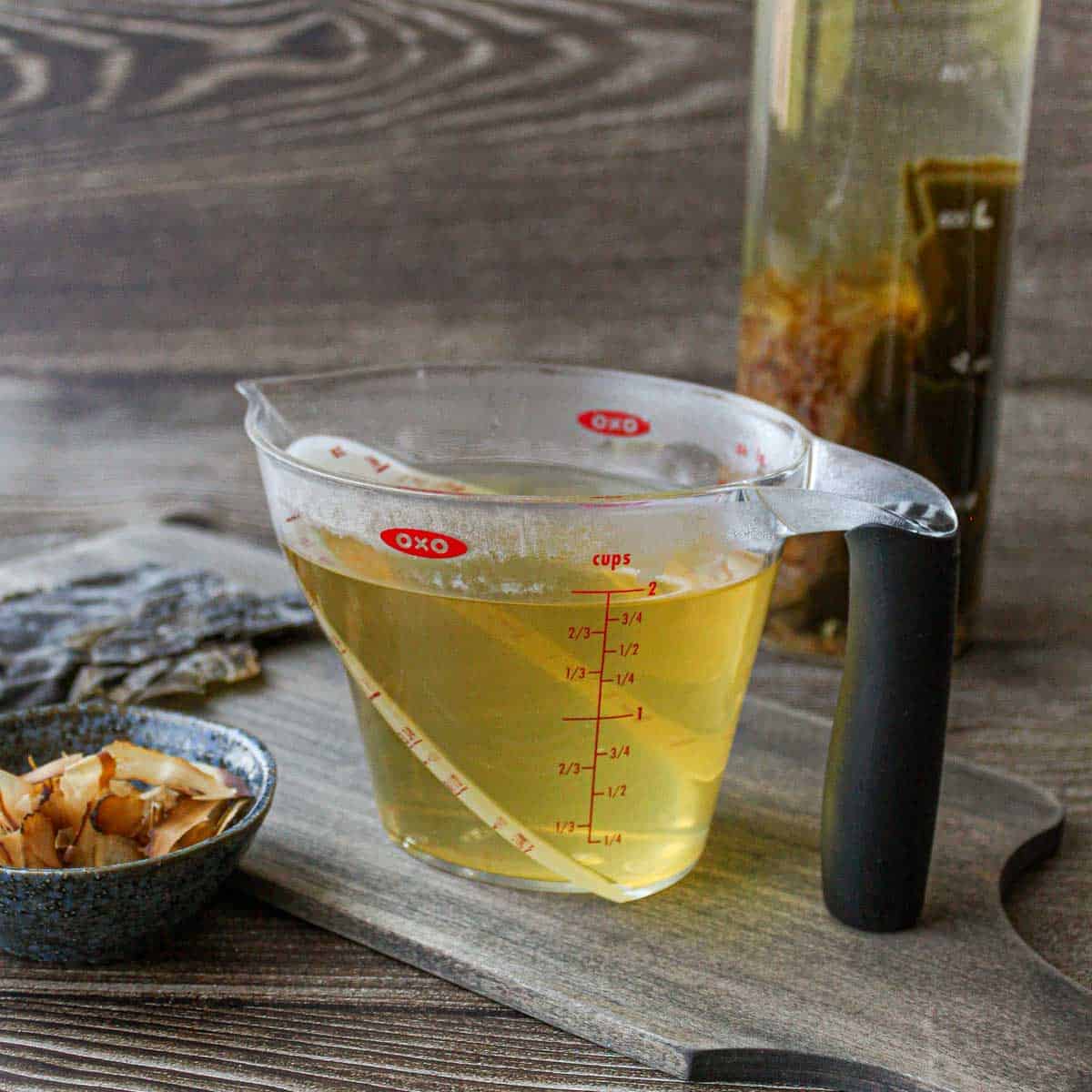
Awase Dashi (Japanese Soup Stock with Kombu & Bonito Flakes)
Ingredients
Method
- Lightly wipe the surface of 10 g kombu with a damp, squeezed-out paper towel to remove any dust. Avoid scrubbing kombu, the white powder on the surface is natural umami (don’t wash it off!).
- Add kombu and 20 g bonito flakes to a container with 4 cups filtered water.
- Cover and refrigerate for 8 to 12 hours.
- Strain through a fine mesh sieve or paper towel. Done!
- Add kombu and 4 cups filtered water to a container. Let it soak in the fridge for 8 to 12 hours.
- Set up a bowl with a colander lined with paper towel for straining later.
- Remove kombu and pour the liquid into a pot.
- Heat over medium until small bubbles begin to rise from the bottom (don’t boil).
- Turn off the heat. Sprinkle in the bonito flakes evenly and let steep for 1 minute (don’t stir!).
- Strain through a colander lined with paper towel. Don’t press or stir the flakes.
- Add kombu and 4 cups filtered water to a pot. Let it soak for 30 minutes to 90 minutes.
- Set up a bowl with a colander lined with paper towel for straining later.
- Heat over medium-low for 20 to 30 minutes, or until small bubbles appear around the edges of the kombu. You should see some steam and smell the kelp. If the thickest part feels soft when you press it with your fingernail, it’s ready.
- Remove the kombu.
- Increase the heat to medium. Once you see small bubbles rising, turn off the heat.
- Add bonito flakes and let steep for 1 minute (don’t stir).
- Strain through a paper towel–lined colander. Don’t squeeze the flakes.
- After straining the ichiban dashi, return the used kombu and bonito flakes to the pot.
- Add the same amount of water as the first brew (4 cups).
- Bring to a boil over medium heat, then reduce to low and simmer for about 10 minutes.
- Turn off the heat. Add about 5g (⅓ cup) of fresh bonito flakes and let it steep for 30 seconds.
- Strain through a colander lined with paper towel.
Notes
- Water: Soft water extracts more umami. Use filtered water (e.g. Brita) if you’re in a hard water area like the U.S.
- Kombu (Dried Kelp): Use thick, sheet-style kombu like WEL-PAC. Ma or Rishiri kombu is best, but hard to find outside Japan. If your kombu seems thin, use a little more. Don’t rinse the white powder, it’s natural umami.
- Katsuobushi (Bonito Flakes): Use thin-shaved (usu-kezuri) flakes like Kaneso Hanakatsuo. Avoid powdery topping-style flakes.
- Substitutions:
- Kombu → Dried shiitake, MSG, or vegetable dashi
- Katsuobushi → Dried anchovies (niboshi), shiitake
- In a rush? Use dashi powder or dashi packs
- Tips: To keep your dish flavorful, pair an amino acid source (like kombu) with a nucleic acid source (like bonito flakes). If you swap one out, add the missing umami component with other ingredients like tomatoes or mushrooms.
- Ingredient Ratio (to Water):
- 4% = Strong dashi for clear soups, chawanmushi
- 3% = Balanced flavor, great for cooking outside Japan (recommended)
- 2% = Light dashi for everyday home use
- Kombu to Katsuobushi Ratio:
- 1:2 = Best umami balance (glutamate:inosinate = 1:1)
- More kombu = Delicate flavor, for suimono
- More katsuobushi = Bold flavor, for miso soup/simmered dishes
- Reusing Ingredients:
Use spent kombu/katsuobushi for:- Furikake (pan-toast with soy sauce/mirin)
- Tsukudani (simmer with soy sauce, mirin, sake)
- Onigiri filling
- Dashi soy sauce (soak in soy sauce)
- Dashi ponzu (soak in ponzu)
- How to Use Awase Dashi: Great for miso soup, oden, dashimaki tamago, simmered dishes, chawanmushi, udon/soba soup, and Japanese curry.
- Storage Instructions:
- Dashi: Store in an airtight container for up to 3 days in the fridge or 2 weeks in the freezer (ice cubes work great for small portions).
- Used dashi ingredients (kombu and bonito flakes): Pat dry and store in an airtight container for up to 1 week in the fridge or 1 month in the freezer.
🎁FREE Dashi Cheat Sheet
📌Pin This Recipe For Later!


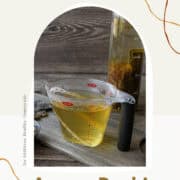

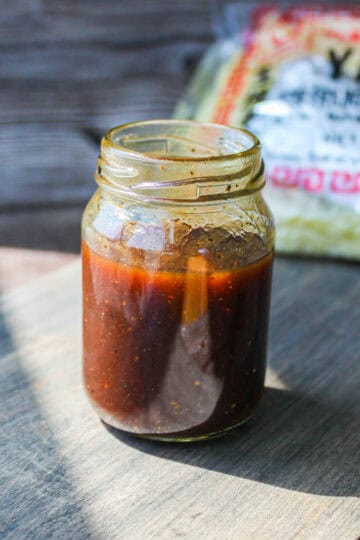

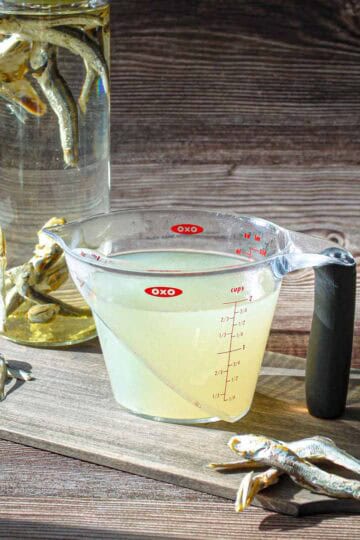
Kurumi says
I loved digging into umami and why dashi tastes so good! I might’ve packed in a bit too much science… 😅 but I hope it didn’t make dashi feel intimidating. Yes, traditional Japanese restaurants take dashi seriously, but for home cooks, it can be simple and sustainable. I hope this post helps you feel confident and makes dashi part of your everyday cooking routine!